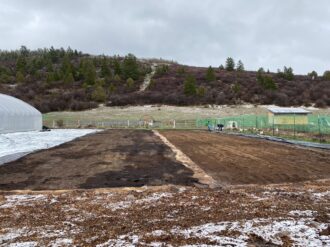Bindweed can be the bane of farmers’ existence. The climbing vine spreads easily by seed and rigorous root system, choking off crops and other plants along the way.
“Even when we till in the spring, we spend a huge amount of time hand weeding throughout the season to manage bindweed,” explained Jonah Sloven, who grows produce at Sweet Hollow Farm in Idaho.
Annual tilling is not ideal for soil health, and the labor cost of hand weeding is high. What if farmers could find a low-cost, sustainable way to control bindweed by harnessing something as basic as cardboard?
Maybe they can. Sloven is encouraged by early results of burying cardboard beneath deep layers of compost to keep bindweed at bay. Sloven and his colleagues recently received a $25,000 Farmer/Rancher grant from Western SARE to explore whether cardboard layers can suppress weeds, improve soil health and increase profits.
Cardboard is especially good at suppressing grassy weeds, like crabgrass, by blocking seed banks from the sun. But researchers have suspected that bindweed, with its aggressive, horizontal root system, could make its way through or around a blanket of cardboard.
In the spring of 2021, Sloven at others at Sweet Hollow Farm decided to give it a try. They cleared out the weeds within 30-by-96 feet high tunnel, laid down two layers of cardboard, covered it with a thick layer of compost, and planted tomatoes.
“The tomatoes really took off, and so did all the crops we’ve planted since then,” Sloven said. “Moving to a no-till system allows a much quicker crop turnover and interplanting opportunities, as well. We’ve had twice the crop production on the same footprint, which is huge for both profit and land-use efficiency.”
The cardboard biodegraded and the soil beneath it is rich with worm activity, aggregate formation and moisture retention – all signs of soil health. Bindweed is not a problem inside the tunnel.
“It’s very sparse and weak in the beds,” Sloven said. “There’s a little more bindweed around the perimeter, but it is so much more manageable than in the field.”
This summer, Sloven expanded the experiment by planting four varieties of squash in two 20-by-100 foot outdoor plots. One plot is managed with tilling and hand-weeding. The second plot is carpeted with cardboard and a deep layer of compost. Both plots are covered in landscape cloth to further suppress weeds.
“We’ll be looking at whether there is a quantifiable difference in bindweed presence between the two plots,” he said.
With the help of a soil lab, Sloven will test soil samples from each plot before and after the study for signs of chemical, physical and biological soil health. Sloven will also weigh the harvested squash each week to compare crop yield.
He will share his results widely throughout the region.
“If successful, this system could be significant for small-scale producers,” Sloven said. “Reducing weed pressure lessens labor hours, lowers costs and improves the quality of life for farmers.”
